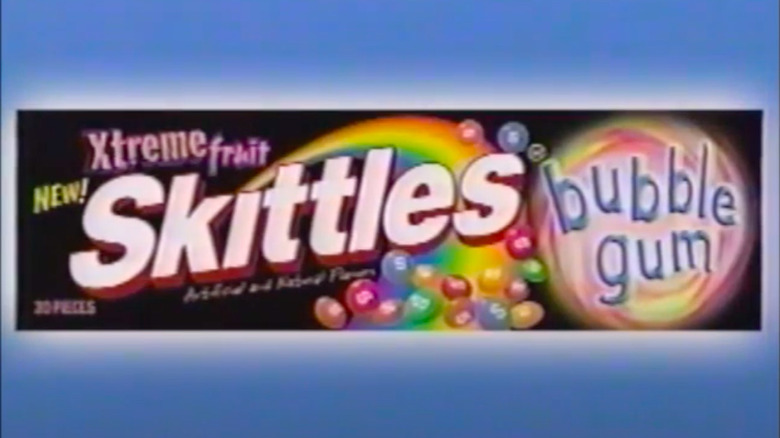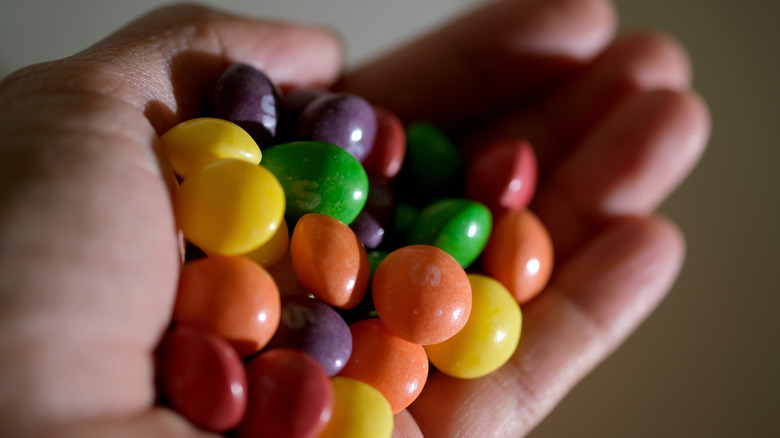How Skittles Tried (And Failed) To Save Its Now Discontinued Bubble Gum
Skittles seems like a brand that you can bet on for success, but even the best among us have their failures. The classic Skittles candies have been a hit ever since they debuted in 1974, and they now rank as the second most popular candy for Halloween in the United States, according to sales data from CandyStore.com (trailing only Reese's Peanut Butter Cups). But Skittles owner Mars Wrigley has also taken some missteps with the brand. Numerous discontinued Skittles varieties have come and gone, most leaving very little behind in the way of positive memories. The notable exception to this trend is Skittles Bubble Gum, which, despite disappearing from shelves over a decade ago, still has a dedicated group of fans clamoring for its return.
Skittles Bubble Gum was introduced in 2004 and discontinued in 2010, yet it still managed to fit a full-on midlife crisis in the midst of its short run. When it debuted, the candy was a straightforward Skittles-gumball hybrid. They were made out of bubble gum, yes, but in all other respects, they were just like classic Skittles. They looked the same, and they had the same fruity flavor as the original variety. But sales of Skittles Bubble Gum were disappointing, so in 2006, Mars revamped the product with a new mix of even fruitier flavors. It was a big swing ... and a total miss.
Xtreme gum makeover
Skittles Bubble Gum didn't do a lot to distinguish itself from classic Skittles, and that may have been part of its downfall. The flavors and appearance of the two candies were identical, and even the packaging had close parallels. Skittles Bubble Gum came in a flip-top box, that much was different, but the red base color, the brand logo, and even the rainbow candy iconography were practically identical. In 2006, after two years of underwhelming sales, Mars Wrigley decided to shake things up both inside and outside the box by releasing a new limited-edition version of Skittles Bubble Gum branded as "Xtreme Fruit."
The original gum came in the same flavors as classic Skittles: strawberry, orange, lemon, lime, and grape. The Xtreme Fruit bubble gum came in blue raspberry, wild cherry, green apple, tangerine, and watermelon. Not only were the flavors different from the original, but as their Xtreme branding suggested, they were also intended to be stronger. And yet, this bold move did nothing to fix the fate of Skittles Bubble Gum, which continued to lag in sales, and ultimately vanished from stores altogether when it was dropped in 2010. What went wrong? The answer is hard to pinpoint.
What went wrong with Skittles Bubble Gum?
Many failed food endeavors can be traced to glaring instances of oversight and/or ignorance (one thinks of McDonald's Arch Deluxe, a "fancy" burger whose ads actually featured kids calling it gross), but that's not the case with Skittles Bubble Gum. It was discontinued due to underwhelming sales, but as for why sales fell short, there doesn't seem to be a clear reason. Instead, a number of factors likely had a hand in the gum coming up short on the market. For starters, Skittles Bubble Gum went against consumer trends at the time of its release. The 2000s saw a major shift in the chewing gum market as the public's attention was drawn toward the negative health effects of sugar. Between 2000 and 2010, sales of sugar-free gum tripled, while sales of sugared gum were slashed in half (via Quartz). Sporting two grams of sugar per serving, Skittles Bubble Gum wasn't the kind of gum people wanted anymore.
There was also the problem of flavor, which applied to both the original and Xtreme editions of the candy. Data from Statista shows that Baby Boomers, Gen X, and Millennials all prefer mint-flavored gum to fruit-flavored gum. If Skittles wanted to shake up their gum's flavor profile, doubling down on fruit was the wrong way to do it. Nowadays, if you want to get your hands on some Skittles Bubble Gum, you'll have to head to auction sites like eBay, where a two-pack of the stuff (one original and one Xtreme) can cost you $200.


